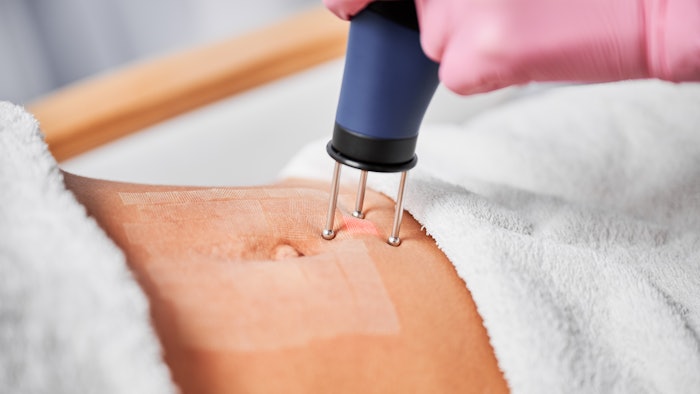Out with the old, in with the new? Not exactly.
Innovative laser technology and upgrades to current devices mark an expansive era in cosmetic treatments.

Advances in laser and energy-based device technology are bringing an exciting array of new treatments to the forefront of cosmetic dermatology. But that’s not all. Many tried-and-true devices and techniques are also getting upgrades and continue to offer a host of options in cosmetic care.
Murad Alam, MD, FAAD, a professor and vice chair of dermatology at Northwestern University in Chicago, is a leading expert in dermatologic laser technology and energy devices. He said the field has many promising pathways to positive patient outcomes. Dermatologists simply need to know the inventory and how it’s best used.
“Laser technology has been broadened in recent years to encompass lasers and energy-based devices, because they often work in similar ways,” Dr. Alam said. “Lasers, of course, rely on visible and sometimes invisible light. Other technologies work in similar ways by delivering radiofrequency or ultrasound energy.”
Fresh innovations
Laser and energy-based devices are no longer limited to cosmetic enhancements, such as wrinkle reduction and hair removal, Dr. Alam said. They are increasingly being used to treat serious medical conditions, including burn scars, vascular birthmarks, and skin tightness and fragility in patients with diseases like scleroderma.
 Murad Alam, MD, FAAD
Murad Alam, MD, FAAD
“It’s not a lunchtime procedure,” he said, “but, perhaps it offers a midpoint between noninvasive treatments and surgical facelifts and is an alternative to skin resurfacing with lasers.”
Another advancement is the 1726-nanometer (nm) laser, designed to treat active acne by targeting sebum-producing glands. This wavelength is selectively absorbed by oil more than by water, said Dr. Alam, allowing it to shrink sebaceous glands without significantly damaging surrounding tissue. While not universally effective, especially in cases of hormonally driven acne, it offers a drug-free alternative for many patients and can lead to long-term remission.
“Why would you want to treat acne with lasers when there are medicines? Historically, we used to treat acne with antibiotics. But people are becoming resistant to antibiotics now, and there’s also a recognition that keeping people on antibiotics for months or years might not be good for them,” Dr. Alam said. “There are some other very good medications to treat acne, like isotretinoin, but that’s a very big gun that has quite a few side effects and is not right for everyone. Novel lasers for acne can also be used in patients with darker skin, because the 1726 nm wavelength can be safer for darker skin.”
The downsides, he said, are that not everyone with acne responds well to this therapy. There can be significant discomfort, and typically the treatment must be repeated multiple times.
Dr. Alam also highlighted focal point technology, a new way of delivering laser energy that concentrates the energy on a small area deep within the skin while minimizing surface damage.
“It’s like focusing sunlight through a magnifying glass,” he said. “This approach allows for more precise treatment of issues such as pigmentation and skin with reduced pain and downtime, potentially.”
Steadfast solutions
Despite the excitement around new devices, many older technologies remain effective. For example, carbon dioxide (CO2) resurfacing, laser hair removal, and Q-switched lasers for pigment removal — all developed in the 1990s — are still widely used today, said Dr. Alam. Additionally, these have evolved into more refined versions, such as Q-switched lasers giving rise to picosecond lasers, which fire in trillionths of a second for even better pigment disruption.
Fractional resurfacing, developed in the 2000s, remains a cornerstone for skin rejuvenation, Dr. Alam said. By treating a fraction of the skin at a time, it reduces downtime and side effects. Non-laser energy devices like radiofrequency microneedling and ultrasound skin tightening also continue to gain popularity for their ability to deliver energy deeper into the skin.
“Sometimes there’s a sense that more things were happening in lasers 20 years ago than are happening now, and to some extent that might be true. But there are still some truly novel technologies,” Dr. Alam said. “And it is important to note that many existing technologies are undergoing modifications and improvements. Although that might sound incremental, I think it has the potential to make a really big difference in how effectively these technologies are delivered and how many people can benefit from them.”
The future: Artificial intelligence, imaging, and accessibility
Just as exciting, Dr. Alam said, are the emerging capabilities. Looking ahead, he said he sees a future where AI, robotics, and advanced imaging will enhance speed, precision, and accessibility.
“Imagine combining high-resolution ultrasound imaging with robotic delivery,” he said. “You could target exactly what needs treatment beneath the skin and deliver treatments quickly and safely just to the area that needs it.”
He also emphasized the growing role of lasers in treating the cosmetic effects of medical conditions, from radiation tattoos after cancer treatment to disfigurements caused by dermatologic diseases.
“More physicians and patients are learning about these technologies,” said Dr. Alam. “Lasers and energy devices aren’t just for treating the visible signs of aging. Many people who are suffering with scarring, redness, and pigmentation caused by disease can now be helped, and as awareness grows, so will access to life-changing treatments.”